Andy Lloyd's Dark Star Blog

Blog 01 (April 2013)
Habitable Zones around Brown Dwarfs
One
of the themes I took up in my novel "The
Followers of Horus" was the habitability of
a moon orbiting a sub-brown dwarf, and how this
might work in practice. The moon would have to
be very close to the primary body to sit within its
habitability zone - as Earth (just about) does with
respect to the Sun - and the likely outcome of this
is that the moon would be in a tidally-locked orbit.
Our own Moon is tidally locked, meaning that it
spins on its axis at exactly the same rate as it
orbits about the Earth, with the result that it
always shows the same face to us. Similarly, a
habitable moon orbiting a Dark Star deep in our
solar system would always show the same face towards
the failed star, meaning that one side of the planet
would be warm, the other much colder.
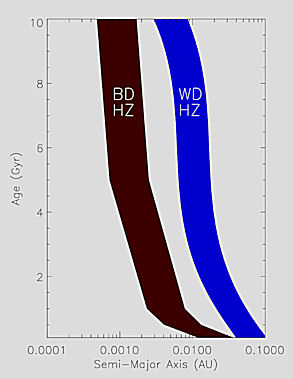
This, and other issues, have been recently discussed
by scientists (1). A paper considering whether
brown and white dwarfs might have habitable systems
has become a talking point (2). Because brown
dwarfs are still not very well understood, it is
hard to say for sure, but barriers to habitability
include the strong ultra-violet light bombarding the
moon during the early life of the brown dwarf,
causing water to be removed from the surface of the
potentially habitable world.
Of
course, such a process likely also happened on Earth
during the early, hotter stages of the Sun's life,
and yet here we are, nonetheless. This is a
point overlooked by academics discussing the
possible existence of water on such worlds.
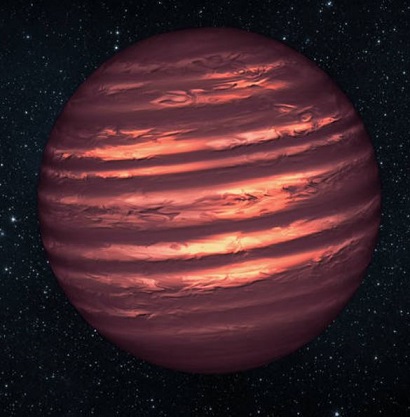
The
impact of water-bearing comets is a possible
solution to that issue, and it seems likely that a
cooled down sub-brown dwarf system in the comet
clouds would also pick up water in a similar way.
Another solution is planetary migration within the
system, where the moon migrates into the habitable
zone once the brown dwarf cools.
The
surprising abundance of water throughout our own
system should give pause for thought before
prematurely discarding the potential for life in
much smaller systems which, lacking the harmful
top-end radiation emission of a powerful star, may
be surprisingly conducive to life.
Written by Andy Lloyd
References:
1)
R. Barnes, R. Heller "Habitable Planets Around White
and Brown Dwarfs: The Perils of a Cooling Primary"
27 Nov 2012
with thanks
to Mark
ncbi.nlm.nih.gov article
2) C. Morley
"Perils of a Cooling Host Star: Life on planets around white and brown dwarfs"
17 Jan 2013
astrobites.org article
Golden Nanobots
When Sitchin first wrote up his
theory about Nibiru, the concept of global climate change was in its infancy,
even among environmental scientists. Itís certainly true that science fiction
writers had thought about terra-forming Mars, etc, but the idea that we were, as
a species, capable of altering our planetís own atmosphere had not really taken
off.

Sitchin proposed that the
Anunnaki love of gold had a pragmatic reason behind it. Earth was a mining
colony, effectively, and the gold was being taken from this world to Nibiru to
somehow help sustain its atmosphere. How this might have been put into practice
was not clear, besides some kind of scattering effect in the Nibiruan
atmosphere. Like the habitability issue, this has been a loose end for many
decades.
But, like so many times,
science has gradually caught up with Sitchin. Itís now easy to see that a
technological, industrialised race might create a spiral of change to a planetís
atmosphere, with potentially disastrous consequences, above and beyond the
natural cycles of change over time. There are now grand schemes being
considered here on Earth to turn the tide of global warming, should its gradual
march lead to significant problems in years and decades to come. Might the
Anunnaki not have had similar issues on their world, perhaps more advanced? And
in what way could gold have been the answer?
One of the regular contributors
to the
Dark
Star Planet X board, Mark Keller, has come up with some new ideas on the
matter. He writes:
"I have had an alternative
idea to the environmental calamity that took place on Nibiru. I wonder if the
problem could have been caused orginally by the Anunnaki trying to terraform
their own planet. As I imagine it, if the planet is tidally locked
[as described in Andy Lloyd's novel
'The Followers of Horus']
then a great deal of the planet could/should/would be uninhabitable. Trying
to increase the heat capturing effects of their atmosphere so they could live on
the majority of the planet could have had similar unexpected consequences on
Nibiru as this post's topic suggests it would were we to try it on Earth.
"Dumping pure finely
powdered gold into the atmosphere may have been as ineffective in the long run
as trying to use the planet's volcanoes, but dumping nano machines that used
gold in some way and/or made of gold could have been more in line for what the
Earth's gold was ultimately used for. These nano machines I propose would have
been controllable, able to congregate and disperse, rise and sink in the air
column when needed to mitigate the negative side effects of geoengineering and
enhance the positive effects."
This highly original idea made
me wonder whether it might one day be possible to create nano-machines that
performed basic chemistry? So, taking Mark's idea of gold-based nano-machines
buoyant within the atmosphere, might they perhaps act as integrated catalysts
designed to take CO2 out of the atmosphere and replace the (allegedly) harmful
gas with a less worrisome carbon-based by-product, which would then harmlessly
fall to Earth? The energy required to drive such a chemical transition would be
provided by UV radiation from the Dark Star, simulating the kind of natural
process taking place in photosynthesis. The Anunnaki would have to have churned
out an incredible number of these nano-machines to make any kind of long-term
impact on a planetary scale. Which would, of course, explain their significant
desire to obtain gold from Earth.
Written by Andy Lloyd
South Pole Nibiru Sighting?
One of the issues
South Pole Nibiru videos has is that the skies over the south pole are
shared across the entire Southern Hemisphere. What is seen over
Antarctica should also be seen in South America, Australia, South
Africa, just from a different angle. So when folk talk about Nibiru
being seen first over the South Pole, then that should also be true on
these other continental areas. I think sometimes they like to project
the idea that the skies over the South Pole are in some way exclusive to
Antarctica, and thus something anomalous seen there has evaded detection
by astronomers in more accessible locations.
Debunking the Debunkers
I caught up with a bit of
reading recently, taking in a book called 'A Secret History of Reptilians' by
Scott Alan Roberts. I don't know the guy, but he had some very strong
opinions on Sitchin's work, particularly with respect to the book's general
theme of Reptilians.
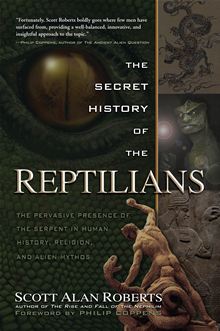
What I wanted to comment on here is how much
Sitchin's work on the Anunnaki has become synonymous with the alien Reptilians
of David Icke's theories. I realise that on the Internet things have a way
of getting a bit puddled. In the old days, when one might have a case of
books to refer to, it was easy to dip into who thinks what, by just referring to
their books. But now we seem to get a lot of our information about who
writes what, online, from secondary sources. It's easier for researchers
to read about what someone's written than to actually take the time, and pay the
expense, of reading the author themselves. Fair enough, until you start writing
your own books taking apart that author based upon what you've read elsewhere
about him or her!
Another point is that Sitchin seems to have had a bad press of late. Everywhere
I see him referred to, it's as a flawed author who might have had some neat
ideas but got a whole load of stuff very wrong, particularly with his
translations. For me, the individual words he 'translated' were not so much the
issue as the overall sense he derived from the texts. Indeed, I've
sometimes read through the officially translated sources he refers to and can
totally see where he's coming from, even when the wording is subtly different.
I'm sure how he depicted the meaning of a given word might be challenged,
sometimes vigorously - that's the nature of that kind of scholarship. But
some of the high-end criticism that many people refer to omits pertinent details
too, or is slanted against his ideas for other reasons.
Regrettably, that just seems to be how it is at the moment. If you want to
look at my criticisms of the book in more detail please take a look at my
subsequent review, which is pretty frank on the matter:
http://www.andylloyd.org/reptilians.htm
Written by Andy Lloyd
Proxima Centauri
I had a recent email from a
reader, D.R., who wondered whether Proxima Centauri (the nearest known star)
might have its own planetary system and whether it might be a possible 'ferry'
between Alpha Centauri and the Sun. He indicated that this seemed a long-shot,
but was intrigued by the possibility nonetheless, spurred on by prior
speculation that nearby and fast-moving
Barnard's Star might
be closer than generally considered.
Regrettably, this imaginative
idea does not create any great potential for interstellar travel.
The problem would be distance, in that ~4
light years would create an elliptical orbit between that system and the Sun's
something in the order of tens, maybe 100s of millions of years (Nemesis's orbit
in the outer reaches of the Oort Cloud is sometimes placed at about 30 million
years, and this would be significantly bigger than that). The vast distances
involved here create a natural obstacle.
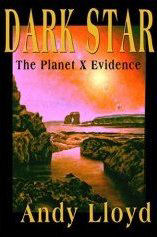
He also wondered whether I was
convinced that the constellation Sagittarius is the location of Nibiru. As
far as Sagittarius goes, I'm not totally wedded to it. It's just that a busy
constellation full of the Milky Way and so on makes a likely hiding place for a
hidden object. A thicker haystack, if you will. It also fits with several
bits of evidence outlined in my book
 The Dark Star.
The Dark Star.
Is Nibiru Sedna?
Another correspondent,
A.N., got in touch after reading my article about the discovery of the
celestial body known as Sedna:
darkstar1.co.uk/sedna.htm.
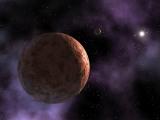
He provided some technical commentary accompanied by these general
thoughts:
"Nibiru
used to be quite large and then at some point, according to Sitchin's
theory, its volcanoes stopped erupting and producing greenhouse gases
that warmed the planet. This is indicative of lessened geologic
activity, the ultimate source of which is non other than the core. This
means that perhaps the activity in the planet's mantle and core were
diminishing. Diminished core activity is a sign of the mantle and core
freezing... as a liquid freezes what effect does it have on volume? If
the liquid is composed of mostly water, the volume should increase. For
any other liquid, the volume would decrease. So as the core and mantle
froze, the volume of the planet shrunk. I am suggesting that perhaps
Sedna, with is brilliant red face, is indeed Nibiru."
Given that the orbital
period of Sedna is similar to Sitchin's Nibiru, this might present a
reasonable consideration, even though Sedna is relatively small.
My particular interest in Sitchin's work is in how a planet beyond Pluto
might be habitable, such that the Anunnaki might enjoy an Earth-like
environment. Within that fairly narrow but important frame of
reference, the Sedna solution does not solve the problems I have been
grappling with over the last 15 years or so, as the loss of atmosphere
and water you speak of creates problems to do with habitability. But
that is not to say that Sedna does not hold some potential - perhaps
life can exist there deep underground, or in artificial domains on the
surface. I remain open to many such ideas as this debate continues.
The Mysterious Latin Text
Correspondence
from Bert Lava (18 April 2013), from Belgium, about some mysterious astronomical
sightings in a Latin journal from 807AD, and whether they might relate to a
passage of Nibiru:
"Here is what I
found in the Annales Regni Francorum about the year 807 AD.
The annals give an overview of things that happened during the reign of the
Kings of Francia. They start with Pepin around the years 750 and continue
over Emperor Charles the Great 746-814 and his successor. They mostly describe
the deeds of the Kings, their wars, and sometimes specific happenings as this
below which is to be found in:
thelatinlibrary.com article
"My knowledge of Latin is not so great, but still I will try
to translate (I am studying latin for 1yr now after pensioning) , nevertheless
help from a real latinist may be better......
"Great Year 4. 9
September there was a moon-darkening, at that time the sun stood in the
sixteenth part of Virgin, the moon in the sixteenth part of Pisces; but this
year at the beginning of Kal.Febr (?) the moon was in the seventeenth part when
the planet Jovis (Jupiter) seemed to pass , and III. Id Febr (?) there was a
sun-darkening at noon, each star in the twenty fifth part of Aquarius . Again
on 4 Kal. March (?) there was a moon-darkening and she appeared back the same
evening and seemed to be enormous, and the sun stood still (fixed - did not
move?), in the eleventh part of Pisces and the moon in the eleventh part of
Virgin. Om the 16th Kal.Apr(.?) the star Mercurius was visible as a small spot
on the sun, but black, a bit above the centre of the star that we have seen for
8 days. But when he first entered or left, the lowhanging clouds obscured our
view. In the month of August XI Kal. September (??) there was a moon-darkening
in the third hour of the night , the sun positioned in the fifth part of Virgin
and the moon in the fifth part of Pisces. So, from the previous year september
till the present year september, the moon was darkened 3 times and the sun once.
"If you want to reply with an explanation or denial, you may do so, but I am not
really interested in Nibiru. But I do find the above happenings somewhat
odd. I'm not a scientist, just an old guy interested in genealogy and thus in
the history of the people around the French and British channel (my ancestral
grounds)."
Bert Lava
Here's my initial reply
followed by some further ideas:
"Dear Bert,
It's very kind of you to write with the information from
the Dark Ages Latin manuscript describing anomalous darkening of the Moon and
Sun. I guess that the most likely explanations are partial lunar eclipses and a
partial solar eclipse. This should be relatively easy to check, but the dates
you quote are tentative by the looks of things, and there's also the added
complication of the change from Julian to Gregorian calendars on October 15,
1582:
wikipedia.org wiki
The dates you mention are Julian dates, and I guess most
eclipse calculators would be framed in the Gregorian reference used today. Back
then there was a 4 day difference between the calendars. So the quoted date of
9th September 807 would convert to our modern calendar as 13th September 807;
similarly for the other dates mentioned. I looked up the full lunar eclipses in
the 9th century here:
wikipedia.org wiki
This brings up 19th May and 12th November 807, which don't
correlate with the three dates considered in your translation.
Similarly with solar eclipses which bring up 7th August and
11th February in 807. These might be a candidates, depending upon the accuracy
or otherwise of the date mentioned, and whether these eclipse events were
experienced over Europe:
wikipedia.org wiki
The real deal breaker is the passage of Mercury across the
Sun, which occurs about 13 or 14 times per century. But I couldn't find a list
of such observed events going back further than 1000 years. A transit of Mercury
across the Sun would last a relatively short period of time compared to the 8
days quoted here, and would be extremely difficult to detect without some kind
of optical equipment. I guess this would explain the lack of Mercury transit
sightings before the 17th century or so! So the claim in the Latin account is
likely describing something else - perhaps a massive sunspot, or something more
anomalous still. Even so, it might be that your translation provides
a rare early documented transit, of interest to students of historical
astronomy:
wikipedia.org wiki
As for Nibiru, that would be a real outside bet from my point of view. But given
that the dates discussed above don't really match what you've come up with in
your translation, then I can't definitively rule out a more unexpected
explanation for the accounts mentioned.
When considering an extraordinary
explanation, like the appearance of a new planet/star like Nibiru, then one
needs to rule out the prosaic explanations first. It's clear that the lunar
eclipses don't fit the dates. Perhaps one of the solar eclipses does as a
partial dimming event.
Here's another consideration; a
supernova.
A very significant 'new' star
appeared around 827AD. the exact date appears questionable, but its magnitude
(at -10) is bright indeed - much brighter than Venus, and therefore bright
enough to be a significant but temporary daylight 'star'. Perhaps your dating
at 807AD is a more accurate one that what is currently recorded.
827 ? Sco/Oph -10
messier.seds.org article
Written by
Andy Lloyd, 18-19th April 2013
The
Stations of the Cross

I've uploaded an article I wrote 5 years ago,
first published in the German Nexus Magazine and updated a few months ago.
It contains a decent synopsis of the Planet X debate, particularly in the run-up
to 2012, as well as some new material about the Stations of the Cross in
Catholic churches and a possible connection to Nibiru:
Planet X Before
and After 2012
Next Blog

Dark Star Blog Index
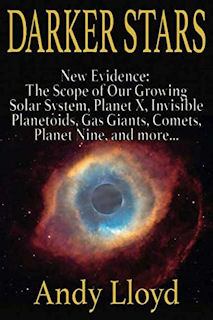
Dark Star
Books Index

You
can keep informed of updates
by following me on Twitter:
www.twitter.com/#darkstarandy

Or like my Facebook Page:
https://www.facebook.com/darkstarandylloyd










